|
present Book Reviews For Amateur & Avocational Archaeologists |
 |
|
present Book Reviews For Amateur & Avocational Archaeologists |
 |
Southwest USA
Archaeology
Southwest United
States
Southeast United States
Mississippian Complexes
All Other United States
Mesoamerica and South America
International (Europe, Africa,
Asia, Caribbean)
Back to Main Book Review Index
|
| Home | Gallery | Latest Finds | Back to Main Book Review Index |
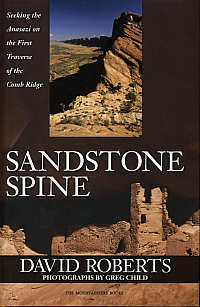
|
Sandstone Spine
by David Roberts The Mountaineers Books 2006 1st edition ISBN# 1-59485-005-4 cloth/hardcover I took this book to a nicely rugged park near my home and read the whole thing in one sitting. Here's the true adventure of three friends, all experienced climbers, attempting to do something no one else had done before: Backpack the entire 100 mile length of an imposing geological anomaly, Comb Ridge, which runs from deep in Navaho Country northward to Utah. Sandstone Spine is a book about a hike, and perhaps more importantly, a story about three friends who love the land and respect the ancient ones who once lived there. Aside from all of the work that went into caching water supplies and strategizing the route to be taken, we learn a great deal about the trio as they wend their way through their journey. Their spats about which way to go, water supplies, and other ephemeral issues serve to flesh out the book, blend in well with the author's sharp eye for emotional as well as literal detail when they discover new ruins or petroglyph walls. You feel like you know these guys, and it lends to the overall feeling of the book. They meet many isolated Navahos on their trek, and the author never lets you forget when the troupe is on Navaho land. He uses every opportunity to explain the cultural intricacies of the area. The book is a whisk through the known archaeology of the area, with important points repeated occasionaly for emphasis. Perhaps my favorite theme, which occurs throughout the book, is "the outdoor museum", where, despite the fierce competition among the group to find artifacts and ruins, nothing is taken away from the site where it is found. Anything handled is placed back in the exact spot in which it was found. In some cases, they even left notes imploring others to respect the outdoor museum idea: The entire area is a museum of how the ancients lived and should be left alone, preserved until we understand more. The author never really reveals the locations of sites they found. The photographs are fantastic and leave you wanting more of them. This would be a "coffee table" book I would buy! I'd buy this one, too, and I'm keeping an eye out for Robert's In Search Of The Old Ones, another tale of his exploration of Anasazi ruins. Sandstone Spine,
which sells for $24.95, can be ordered direct from the publisher,
The
Mountaineers Books, by clicking here.
reviewed
by
Bob
Wishoff
|
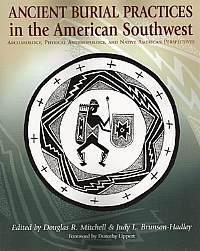
|
Ancient Burial
Practices in
the American Southwest: Archaeology, Physical Anthropology, and Native American Perspectives edited by Douglas R. Mitchell and Judy L. Brunson-Hadley University of New Mexico Press 2003 1st paperback printing ISBN#0-8263-3461-X oversized paperback Examination of the burial remains of ancient peoples has been standard stock-and-trade in archaeology for decades. Burial sites frequently present the researcher with details of ancient life that can be found nowhere else. Insights into cosmological perspectives, religious beliefs, dietary habits and general genetic data can be illuminated through the study of burial sites. Ancient Burial Practices in the American Southwest is a collection of nine papers intended to bring together in one volume all of the current thinking relative to approaches to research, techniques and analyses as practiced by the Southwest’s most prominent archaeology, anthropology and paleopathology professionals, as well as an intriguing essay by Hopi tribal historians. Recreating cultural patterns through analysis of case studies and population analysis, we are presented with the latest information about Hohokam, Anasazi, Singua, Zuni, Mogollon and Salado cultures. The depth of information presented is vast, and top-notch. Discussed also, are the repercussions of the Native American Graves Protection and Repatriation Act (NAGPRA) relative to burial research, both by the scientific community and by Native Americans. The included essay “Hopi Perspectives on Southwestern Mortuary Practices” is interesting in that it is rare to find such essays in this type of examination. In fact, the editors of this volume do not take the usual perspective toward NAGPRA as adversarial: “One can easily argue that there have been both positive and negative effects on scientists’ abilities to learn about ‘our’ past (‘our’ being the entire human population), but clearly NAGPRA has opened the door to many positive interfaces, which have been neglected and ignored in the past, between archaeologists and tribes… clearly the current editors’ biases are of the belief that mortuary studies can provide important additional insight into learning about ancient populations.” Treating remains as people and not merely “things”, and keeping in context the wishes and beliefs of the deceased’s tribal affiliations is a theme more and more recurring since NAGPRA came on the scene. As a whole, we tend to associate immortality as a primary function of ancient burials—we are particularly affected by the popular archaeology we see in museums, especially the Egyptian cultural heritage. It is easy to forget that not every culture’s beliefs are centered on such concepts. The essay regarding Hopi perspectives is very clear: “The archaeological excavation of graves to recover human remains or grave goods interrupts the natural process of returning to the earth that is essential to the metamorphosis of human remains into the fertile, life sustaining tipkya associated with each Hopi village.” Indeed, according to the authors, NAGPRA presses unique burdens upon tribes as new rituals for reburying remains, in the case of the Hopi, needed to be created as previously remains were never disinterred after appropriate burial rituals had been performed. The point is also made that NAGPRA created many opportunities for archaeologists and other scholars to be informed of otherwise secret rituals that Hopi had not truly desired to reveal before the law was passed. In fact, NAGPRA forces both Native Americans and archaeologists to work together. The rest of the book contains interesting analyses of southwest burials which reveal something of the cultural organization of prehistoric societies in the region. These studies reveal a complex structured society where participation in several sodalities (social/religious/political entities) differentiated burial ritual and goods. Indeed, existence of these most of these societies is evident only in statistical analysis of burial offerings. Evidence of other sodalities is confirmed through corresponding ethnographic evidence. A paper also explores health and dietary stresses as discovered by examining remains found at La Plata, noting how ironic it is that one can study the dead to ascertain the health of a living community through time. Ancient Burial Practices in the
American Southwest
can be ordered directly from its publisher for $24.95, by clicking here. reviewed
by
Bob
Wishoff
|
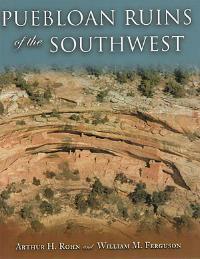
|
Puebloan Ruins of
the Southwest by Arthur H. Rohn & William M. Ferguson University of New Mexico Press 2006 ISBN# 0-8263-3970-0 paperback Originally published in 1986 as Anasazi Ruins of the Southwest in Color, this is an unusually appealing book, one that anyone who visited ruins in the Four Corners area should have in their library. It presents not only the unique architectural qualities and significance of the most important and accessible sites but does so in a manner that emphasizes their place in the development of Anasazi and Puebloan ways of life. There is a large introductory section which gives a clear overview covering not only architecture but timelines, physiological qualities of the people, agriculture, water management issues, clothing, tools, ceramics, basketry, government, warfare, trade, spirituality, astronomy and migratory patterns. The beautiful color photography by the authors is one of the outstanding aspects of this book, including low level aerial shots that offer rarely seen views of many well known sites and ancient roads. They help give a sense of larger structural properties not always apparent from the ground, especially those which are accompanied by line drawings of the ground plans. There are also a large number of excellent colored maps with highlighted terrain which illustrate not only the geographic limits of different Basketmaker and Pueblo periods but give a feel of the environment that shaped helped to shape those cultures. Ruins are grouped into five major regions. The Northern San Juan Region includes Mesa Verde, Hovenweep and the Montezuma Valley. The Kayenta Region encompasses Betakin, Keet Seel and Canyon de Chelly. The Chacoan Culture complex and its outliers are given a separate chapter, as are the Zuni and Hopi ruins of the Little Colorado River Region. The more recent Northern Rio Grande sites which begin to include Spanish influences are looked at last, leading into the historic era of Pueblo culture. For anyone with an interest in the
prehistoric
ruins of the Southwest this is a must-have volume. Even if you’ve
visited some of the sites, you’ll be sure to learn more about them, and
if you’re planning a trip to the Four Corners area it serves well as a
guide to many lesser known sites well worth a side trip. A few copies
of
the earlier, 1986 edition of Ferguson and Rohn’s book might still be
available,
but with more than twice as many color photographs, the addition of new
material and a more contemporary layout, the new edition is clearly an
improvement on what was already a classic. In a large, 8.5 x 11
format
and 336 pages, it is available in either hardcover ($60.00) or
paperback
($34.95) from the University of New Mexico’s website for the book by
clicking here.
reviewed
by
Charles
Swenson
|
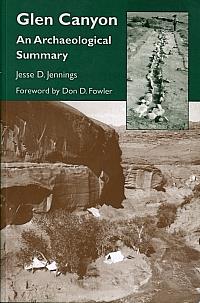
|
Glen Canyon: An
Archaeological
Summary By Jesse D. Jennings University of Utah Press 1998 reprint ISBN# 0-87480-584-8 paperback Lake Powell, in Nevada, is the most visited of all National Park sites in America, but few, if any, of the lake’s visitors know much of anything about the wonderous places that were inundated by the flooding of the Colorado River that created it. For beneath the waters of Lake Powell is Glen Canyon, called by among other John Wesley Powell, “a curious ensemble of wonderful features—carved walls, royal arches, glens, alcove gulches, mounds and monuments.” Amazingly, “For nearly a century, the name and the place were mysterious, fabled…” and “probably less than three hundred people ever ‘ran the river,’ boated through the canyons of the Colorado, and especially Glen Canyon--- until the middle 1950’s when final plans were announced to build the Glen Canyon Dam and create Lake Powell behind it.” The dam, which would flood the area, necessitated a massive, though not complete, archaeological survey and salvage operation which took five years and involved “scores” of workers. some book covers really hook you; this one really hooked me... just look at where these folks were working! It took four attempts by the author, project head and legendary archaeologist Jesse D. Jennings, to write this summary of what was accomplished in Glen Canyon, and this book was worth the wait. Actually this book is a reprint, in book form, of the original 1966 journal publication. It is an interpretive summary, and extremely readable at that, covering the archaeology, ecology, geology and history of the canyon and its tributaries. The book contains wonderful photographs of some impressive vistas and even more impressive archaeology, such as one shot of pole-impressed mud where a shelter once stood, and several shots of superposed structures I’ve not seen elsewhere. Jennings certainly had his job cut out for him in trying to summarize the massive amount of data he and his team amassed. Some of what was found there was unique, and and a great deal of the tenor of the book bemoans what was lost as there was a lot of space to cover in a small amount of time--- but much was also gained by the research, including insights into the mysterious Fremont culture. The author also credits the study as an early motivator for more studies in the region. There is a push at this time to drain Lake Powell, so the book also has a contemporary political side to it. Glen Canyon: an Archaeological
Summary is an
interesting book--- we can thank the University of Utah for reprinting
it! It sells for $14.95 and can be ordered directly from the
publisher
by clicking here.
reviewed
by
Bob
Wishoff
|
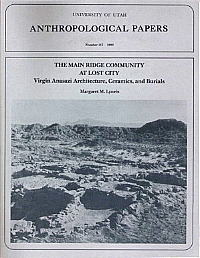
|
University of Utah
Anthropological
Papers: The Main Ridge Community at Lost City By Margaret M. Lyneis University of Utah Press 1992 ISBN# 0-874-80411-6 paperback This report is comprised of the integration of two excavation studies and three collection studies of this Main Ridge Lost City Anasazi community located on the shores of Lake Mead. The studies were undertaken because Lake Mead waters were rising and water lines were cutting into the ruins of the community, eventually damaging most of it. Main Ridge, located in southern Nevada, is a concentration of many ancient households situated at the pass between the Muddy River and the Virgin River. “The large size of the site and its unique positioning suggest that it is well suited to provide a perspective on the nature of the Anasazi occupation in southern Nevada and its relationship to other Anasazi to the east. The Virgin Anasazi region is the least known of the six Anasazi subdivisions. It was abandoned before the developments of Pueblo III times that elsewhere produced large pueblos and cliff dwellings, ruins that have long attracted archaeological investigation. Much of the Virgin Anasazi area today remains of difficult access, discouraging investigation. No large-scale federal endeavors have affected the area, so there have been no major projects in it. Without a Chaco Canyon or a Mesa Verde or a Tsegi Canyon, and without a Black Mesa Archaeological Project or a Delores Archaeological Project, the level of understanding of the Virgin Anasazi lags far behind that of other Anasazi regions. Yet, in the context of the Pueblo II cultural landscape, the Virgin Anasazi were at their peak, one of the distinctive Anasazi developments, maintaining their cultural identity across several hundred kilometers of terrain and supporting their communities in the startlingly contrasting environments of the plateaus at 1500-2100m and the margins of exotic streams cutting through barren regions of the Mojave Desert at 400-550m.” This is a complete anthropological study and covers in rich detail, every facet of Virgin Anasazi architecture, ceramics and burials and includes new research, as well as data collected in the original 1920 investigation. The book is meant to come with a diskette, missing in my review copy, with all of the tables of data which accompany the monograph. Part of a larger series of
Anthropological
Papers published by the University of Utah, it is an interesting
example
of what a completed study should look like and what it should contain,
and is a worthy read for any interested student seeking a model for
their
own writing projects. The Main Ridge
Community
at Lost City, can be ordered, for $25.00,
direct from the University of Utah Press, by clicking here.
Other publications from this excellent series of 125 volumes (only nine
of which are currently in print), can be ordered by clicking here. reviewed
by
Bob
Wishoff
|
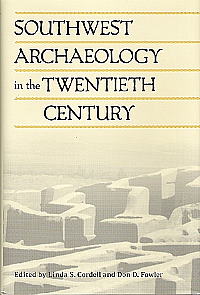
|
Southwest
Archaeology in the
Twentieth Century Edited by Linda S. Cordell & Don D. Fowler University of Utah Press 2005 ISBN# 0-87480-825-1 cloth hardback American archaeology has evolved immensely over the past hundred years, and the development of its applications in our understanding of the pre-Columbian and protohistoric Southwest can be traced throughout the numerous contributions in this volume. As academically archaeology is often considered a subset of anthropology, it is not surprising that this collection of 15 papers arose out of a symposium at the 100th Annual Meeting of the American Anthropology Association, with a focus on the previous century’s “transformation of anthropology, including the changing relationship between archaeology and other subfields of anthropology.” The book is divided into two sections, one on the contexts and the other on the contributions of Southwestern archaeology. The first contains many valuable insights for lay readers with an interest in the subject but little historic background on the characters and institutions central to the subject, while for the more widely read there is enough richness of detail to broaden their perspective into areas they may have overlooked. Characters such as Jesse Walter Fewkes, Clark Wissler, Alfred V. Kidder, Edgar Lee Hewett, Frank Springer, Charles DiPeso, Emil W. Haury (to name only a few) emerge as living, breathing personalities, rather than just reference sources. The role of museums, universities, archeological and historical societies, private foundations and conferences in shaping research is given considerable coverage as well. Separate chapters are devoted to a more in depth discussion of subjects such as the development and influence of field schools in research, the impact of the growing number of privately managed Cultural Resource Management programs and the transnational aspects leading to increased awareness of archaeology in Northwestern Mexico. The findings resulting from the growth of new techniques and methods of anthropological and archaeological research over the past century are expanded on in the second half of the book. A chapter on paleoenvironmental reconstruction manages to present the good news along with the bad, that while Southwest archaeology is “…blessed by spectacular preservation, a diverse array of potential datasets, and a vast body of method and theory…students become, in effect, highly specialized apprentices, with no guarantee that employment opportunities will arise in the long run.” Another chapter gives a good overview of what we’ve learned over the previous century of the preceding ninety nine, while others cover issues such as social complexity, issues of ethnicity and ethnography, and early mission history. A final discussion chapter addresses the question of how previous themes and trends will affect the future of archaeological research in the Southwest. Cordell and Fowler have compiled a
thought
provoking series of essays that will appeal to the serious student of
archaeology
and anthropology, while the avocationalist will gain a breadth of scope
that is not always apparent to the non-professional. This is yet
another fine publication on the subject of Southwestern archaeology
from
the University of Utah Press, and it can be ordered directly from them
from their website by clicking here.
It is currently only available in hardcover, with 21 illustration and 2
maps, for $45.00. reviewed
by
Charles
Swenson
|
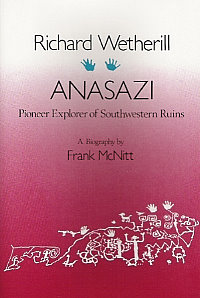
|
Richard Wetherill: Anasazi Pioneer Explorer of Southwester Ruins A Biography by Frank McNitt University of New Mexico Press (1957) 1993 10th paperback printing ISBN 0-8263-0329-3 Mesa Verde, Chaco Canyon, Grand Gulch, the Basket Makers --- these are all names familiar to anyone with an interest in the prehistoric past of the American Southwest. And all have at least one thing in common, namely the essential role of Richard Wetherill in their rediscovery. Greatly disparaged by a number of professional archaeologists and academics for his technique despite his undeniably important contributions, Wetherill remains one of the first as well as one of the most enigmatic figures in the exploration of ancient Anasazi cultures in the Four Corners area. As an avocationalist with no formal training, his reputation suffered tremendously due to criticism by the fledgling archaeological community and federal agents, castigated as a pothunter and vandal even while he produced research profound in its insights. His troubles didn’t stop there; he was also often branded as a horse thief, hovering on the edge of poverty and pursued by creditors, and hounded by an Indian agent jealous of his close relationship with the local Navajo. During his last days he was even denied the right to do any work on the ruins in Chaco Canyon, although he was homesteading literally within a stone’s throw of Pueblo Bonito. Though well respected by the Navajos he lived amongst, almost single-handedly bringing new life into their hand-woven blanket trade, the last words he heard were uttered by the Indian neighbor who’d shot him, asking “Are you sick, Anasazi?” before placing a final bullet in his head. Frank McNitt wrote this definitive of Wetherill in 1957, when it was still possible to draw on over 20 interviews with people who’d known him or his family personally. He also draws on contemporary newspaper accounts, court records, Indian Office files and the well kept notes of his numerous journeys with the Hyde Exploring Expeditions. His skillful portrayal conveys the sense of the quiet Quaker rancher struggling to make a living in some of the most barren regions of America at the dawn of the twentieth century as well as the man whose obsession with understanding the Anasazi became as intractably intertwined with the cliff dwellings as the “R. Wetherill” he so often carved at the sites he worked at. This is not an academic book by any means; he even bemoans the lack of footnotes in the Sources & Acknowledgements section of the second edition. Instead it is an extremely well researched, highly enjoyable biography that will appeal to a wide range of visitors, from the casual reader who has visited the Cliff Palace at Mesa Verde and wondered about its discovery, to the professional seeking insight into the mentality of the avocationalist who produced some of the earliest and most significant research in Southwestern archaeology. The quality of McNitt’s writing throughout is excellent, producing a narrative that flows throughout Wetherill’s life, embroidering it with a level of detail that makes it a portrait of turn of the century life on the frontier as well. It is a story you may already know, but after reading his telling it is one you will never forget. Since the book itself is almost half a century old, there are some touches that seem a bit dated though actually quite useful, such as a table of contents which includes a terse synopsis of each chapter (“NINE: The Hyde Exploring Expedition undertakes the excavation of Pueblo Bonito. George H. Pepper as field director. Trenching Bonito’s refuse mounds. Discovery of small burial sites. A cache of pottery and two burial rooms are found. Friction between Richard and Pepper. Marietta Palmer and Richard Wetherill are married at Sacramento and return to Alamo Ranch. Plans for a second Grand Gulch expedition.”). There is an interesting epilogue summarizing the “later circumstances involving some of the principals of this story”, and the appendices include a number of letters by Wetherill, a contemporary account of “the discovery and early exploration of the cliff houses at the Mesa Verde” put together by Richard Wetherill’s brothers shortly after his death, and a count of the burials found at Pueblo Bonito. (Wetherill shared the penchant of his peers for seeking out burials, skeletons and mummies, a practice common prior to NAGPRA legislation that would have precluded a great deal of his work, though producing little or no controversy at the time.) McNitt also illustrated the book, including some outstanding hand drawn maps, and the photographs show some interesting views of pre-restored Anasazi sites. It is no wonder that this book is still in print half a century after it was first written. This is a perfect compliment for anyone who has visited the sites he rediscovered, the ideal tale of a cusp in time where history and prehistory are juxtaposed. The tenth paperback reprinting (as of 2003) by the University of New Mexico Press is a genuine bargain for only $19.95 (383 pp) from their website here. For those with a further interest in the work at Wetherill
in exploring
the Grand Gulch, site, two books attempt an exercise in ‘reverse
archaeology’
to trace back their expeditions from their notes, the artifacts they
shipped
back east, and the extensive number of photographs they took.
Cowboys
& Cave Dwellers (School of American Research Press, 1997) is
probably
the best book available about the Wetherill-Grand Gulch Research
Project,
with many excellent ‘then and now’ photographs of the sites and
artifacts
from the expeditions of Wetherill and others. Anasazi Basketmaker
- Papers from the 1990 Wetherill-Grand Gulch Symposium (Cultural
Resources
Series, No. 24, United States Department of the Interior) is another
valuable
resource for those interested in Wetherill’s work as well. You will
find
both volumes reviewed here. reviewed
by
Charles
Swenson
|
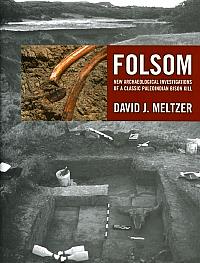
|
Folsom New Archaeological Investigations of a Classic Paleoindian Bison Kill By David J. Meltzer University of California Press 2006 1st ed . ISBN# 0-520-24644-6 cloth hardback Folsom — the name alone conjures up visions of mammoth hunters and for many, it’s the legendary site, discovery of which opened up “deep time” and gave researchers the ”room” they needed to begin to fill in the chronology of the Americas. Interestingly, though, is the fact that the complete results of this historic excavation had, before this volume, never been published! Interesting too, are the facts surrounding the discoveries at the Folsom Quarry--- so much politics, so much controversy. Author David Meltzer, Henderson-Morrison Professor of Prehistory at Southern Methodist University and Director, QUEST Archaeological Research Program, has written a most-readable book covering virtually every conceivable angle of interest regarding the Folsom site. The section of the book covering the discovery of the site is absolutely fascinating and could sell as a book on its own. Why, for instance, did it take nearly 20 years to get anyone out to the site after George McJunkins’ discovery? We learn of how two classic characters of early American archaeology, Harold Cook and Jesse Figgins “promoted” their sometimes spurious ideas of the deep past of human occupation, muddling the already controversial nature of the topic and raising the ire of powerful skeptic Ales Hrdlicka, who refused to accept any suggestion of Pleistocene. What a great movie this story would make!!! The appendix presents us with the Folsom Diary of Carl Scwachheim, a local blacksmith, who along with Fred Howarth, were perhaps the only constants in the site’s twisted story. Not only does this book revisit the original excavation, giving us every detail of its operation, but it presents it side-by-side with the results of two much more recent excavations. Meltzer’s projects took a site, supposedly with nothing more to find and found intact archaeological deposits. In addition, he and his crew remapped the site and applied new methodologies and observations which were unknown to the original excavators. We are presented with excellent, understandable, readable chapters concerning the Folsom Quarry’s geology, site formation, ecological studies, pollen, biota and taphonomy studies, artifact technology studies, and, as an added bonus, excavation results from studies of the original excavators’ camp (as they have also become a part of the history of the site!). Absolutely the be-all and end-all book on Folsom, this is one of the most intriguing, well-written books I’ve read in a long time. The side-by-side narrative of both modern and original excavations is a style worth repeating in other such books about classic sites. Get a copy of this book for yourself, or pick one up as the perfect gift for anyone interested in archaeology, particularly the origins and adaptations of the First Americans. Folsom: New Archaeological
Investigations
of a Classic Paleoindian Bison Kill is available direct from
the publisher, for $55.00, by clicking here. reviewed
by
Bob
Wishoff
|
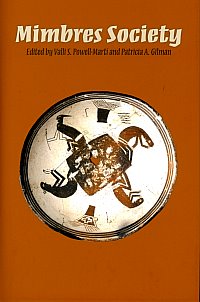
|
Mimbres Society Edited by Valli S. Powell-Marti and Patricia A. Gilman University of Arizona Press 2006 1st ed. ISBN# 0-8165-2481-5 cloth hardback From “Mimbres Society”(the introduction), written by the
co-editors: So much has been researched and written about the artistry that most of the other important questions about Mimbres culture have been largely ignored. For instance, Mimbres society is widely considered to have been egalitarian in nature, but this book collects together compelling arguments for subtle differences in social status of some individuals and social groups. Mimbres Society consists of nine papers created for “a Mogollon Conference session… present(ed) in Las Cruces, New Mexico.” The papers are grouped into three parts: Social Contexts of Mimbres Architecture, Social Contexts of Mimbres Ceramics and Concluding Thoughts. Architecture from several sites is compared—room size, number of doors, and other relevant details are compared and connections of bowls to rooms are analyzed. Burials contained in rooms are also analyzed—the grave goods adding more important context to room differentiation and what might have taken place in the rooms, but analysis paid special attention to burial placement. Wall construction and the relationships of nearly every architectural feature are explored. Patricia Gillman writes, in her paper about the Mattocks Site, “We know little about how materials such as pottery and rare or exotic goods played a role in differentiation among people in a social setting such as that in the Mimbres valley, and this investigation implies that they may not always do so.” Were apparent suites of rooms evidence of status, large families, or evidence of “corporate” manufacturing spaces? Social Contexts of Mimbres Ceramics, examines iconography to find inferences of Mimbres gender and sex concepts. It would seem that there was indeed a distinct gender-based division in day-to-day activities “such that men hunted large game and participated in ceremonies, while women cared for children, carried burdens, and tended parrots.” As in many cultures women’s activities were not the source of prestige— women didn’t seem to socialize as widely as men either. Who made Mimbres pottery? Was it made by individuals or families, or “specialists”? For those not familiar with this kind of investigation, this book will prove fascinating, as you will see precisely how such inferences are made. Remember, when investigating prehistory, archaeologists can only draw inferences about social structure from material remains—and this book attempts to actually recognize the works of individual artists and artist-families. In fact, analysis of pottery styles and compositions allows the authors of papers to show a chronology of trade patterns among the pueblos in the entire Mimbres valley. These papers, though very technical in nature, illustrate further how archaeologists make important inferences about ancient cultures—and how the very structure of a society can be evoked from statistical analysis of raw data. Concluding the book Michael Diehl writes, “Collectively, the contributors demonstrate that anthropologists have become very good at generating ways to tease patterns from archaeological data and at conjecturing about social phenomena.” In my opinion this should be a good reason for amateurs and avocationalists to read this book, regardless of whether they are particularly interested in Mimbres culture. Though technical in places, I found that the book’s contributors make it all very readable and illustrate their points through the use of many excellent charts, drawings and photographs. An excellent reference/bibliography section rounds out the book. Mimbres Society can be
ordered, direct
from the publisher for $50.00, by clicking here. reviewed
by
Bob
Wishoff
|
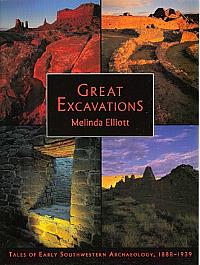
|
Great Excavations:
Tales of Early Southwestern Archaeology, 1888-1939 By Melinda Elliott School of American Research Press 1995 1st Ed. ISBN # 0-933452-43-8 paperback “World War II brought down the curtain on the first fifty years of archaeology in the Southwest. The days of romantic, adventuresome excavations led by individualistic pioneers in archaeology and anthropology ended as far-reaching technological, economic, and societal changes redefined the face of scientific research. No longer would archaeologists in the Southwest conduct large-scale excavations that aimed to uncover as much as possible of a site, simply in order to find out what was there.” (p.213) Melinda Elliott has compiled a welcome volume on the history of some of the greatest excavations in the Southwest. The sites are well known to anyone with an interest in North American prehistory---Mesa Verde, Pecos Pueblo, Aztec Ruin, Hawikuh, Pueblo Bonito, Snake Town, Awatovi, Betakin. While she does include a great deal of insights on the ancient cultures and the architectural monuments they left behind, her focus is more on the archaeologists whose work on these sites helped to shape our understanding of the people who came before there. Each of the first 7 chapters focuses on a specific site in the Four Corners area and the excavations carried on there, while the last builds on the Rainbow Bridge-Monument Valley Expeditions of 1933 to 1938. These archaeologists about are eminent figures as well ---J.W. Fewkes, A.V. Kidder, Earl Morris, F.W. Hodge, Sylvanus Morley, Neil Judd, Emil Haury, J.O. Brew, Watson Smith, George Brainerd, John and Ben Wetherhill. They are often only vaguely familiar because their names crop up so often in the literature associated with their research. But it is Elliott’s gift in this book to bring them to life as human beings caught up in the exciting adventure of uncovering the past by digging into ancient ruins in lonely, hostile environments. Extensive interviews with a number of archaeologists (including Smith and Haurig), their colleagues, and their families allowed her access to a broader understanding of their personalities as well as their research. Details of their lives and field work are found here that won’t be found in their published accounts, fleshing out the accounts of their excavations in a way that helps us to understand how they were the pioneering spirits pushing the boundaries of American archaeology at a time when it was just beginning to emerge as a field of legitimate scientific enquiry. Other fascinating characters also emerge throughout the book as well. We meet the garrulous retired financial wizard and amateur archaeologist Harold Gladwin who, spurred by a friendship with Kidder, founded the seminal Gila Pueblo Archaeological Foundation, a breeding ground for much of the research and investigation into the budding understanding of the prehistoric Southwest. There is also Al Lancaster, a hardscrabble farmer and part time prospector with an eighth grade education who eventually turned his jack of all trades skills to wrangling work crews, stabilizing sites and assisting at many of the digs chronicled here. Quickly one begins to understand that the personal qualities of the investigators at the sites played a significant role in the nature of their discoveries. The period covered here also saw major technological advances in the practice of archaeology. The developing use of stratigraphic analysis of sites is uncovered in a way which demonstrates not only its rationale but its usefulness. The newly discovered use of tree rings is used on cross timbers at Aztec Ruin and Chaco Canyon for determining a firm timeline for dating their construction, establishing A. E. Douglas as a major figure not in his chosen field of astronomy, but rather in the newly established science of dendrochronology. Other shifts in excavation practices are also clear by their current absence. The widespread removal of skeletal remains and collection of grave goods was common at these sites that one chilly night Richard Wetherill brought mummies to bed with him and his wife to protect them during a particularly wet winter night; it is now so delicate a subject that even the numerous photographs taken of them at the time are excluded. And it is the photographs that profusely illustrate Great
Excavations
that provides one of its great attractions. As stated in the
Picture
Credits: Elliott has made liberal use of this vast resource, with
130 black
and white photographs to richly enhance the text, lending the mind’s
eye
a more solid idea of not only the sites, structures and discoveries,
but
also of the individuals involved in the excavations. Not only the
archaeologists portrayed here, often in whimsical and smiling photos
taken
in the field at the height of their career establishing work, but also
of the crews, consisting of local Indians, as well as students and
fellow
archaeologists. These photographs make this book a real joy not
only
to read, but to casually peruse time and time again. They help
take
the reader back one to an era when Southwestern archaeology was in its
prime not only as newly emerging science, but also as a source of
exciting
discoveries and exploration by rugged individuals in exotic
locations. Published by the School of American Research Press, Great Excavations is available directly from their website (click here). At $19.95 it is a genuine bargain. While geared for a much wider reading audience with an interest in Southwestern archaeology, this book will nonetheless delight any avocational or professional archaeologist. The SAR Press also offers a number of other fine books on similar topics. I also unequivocally recommend their Cowboys & Cave Dwellers, (reviewed elsewhere on DirtBrothers.org), which retraces the discoveries of the earliest expeditions to the Grand Gulch sites in Southeastern Utah. These books are an absolute delight, wonderfully illustrated and very well written, and a real joy for any student of the prehistoric Four Corners area. reviewed by Charles Swenson |
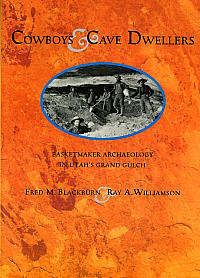
|
Cowboys and Cave
Dwellers: Basketmaker Archaeology in Utah’s Grand Gulch By Fred M. Blackburn and Ray A. Williamson School of American Research Press 1997 4th paperback printing 2004 ISBN # 0-933452-47-0 Anasazi
Basketmaker: This beautifully illustrated and wonderfully engaging book details the detective work of the Wetherill-Grand Gulch Project in tracking back over the earliest expeditions to the Grand Gulch region of Southeast Utah at the end of the 19th century. It brings together the discovery of the Basketmaker Anasazi culture as a separate entity, the rise of Southwestern archaeology as a disciplined science, the rediscovery of the ultimate location of artifacts that had seemed lost, and the ongoing struggle against pothunters to preserve a great American historic legacy from destruction. During the final decade of the 19th century there were at least 12 organized archaeological collecting expeditions in the Four Corners region of the American Southwest, most of them focused on the Grand Gulch region of southeastern Utah. While there was a strong exploratory element to discover new and untouched ruins to them, the hallmark of these expeditions was the collection of artifacts. The ultimate disposition of these artifacts became murky. It was not uncommon for items to wind up in the hands of private collectors, and a large number at one point even formed the basis exhibition at the World’s Columbian Exposition in 1893. But more often these collections were lost in the dusty storage rooms of museums, the collections at times being broken up without clear provenance being attributed to them. The signatures of early expedition members such as Richard Wetherill and others left were often inscribed at the sites they worked in Grand Gulch. Fred Blackburn, who’d worked as a Bureau of Land Management ranger in these canyons, often conjectured about the possibility of ‘using the signatures to determine both the routes of the most significant Grand Gulch expeditions and original alcoves or rockshelters from which artifacts had been taken.” On five day recreational trip into the area, Blackburn and four other like minded avocational archaeologists agreed to work on just such a venture, forming what was over the next four years to become the Wetherill-Grand Gulch Project. Over the next four years the size of the Project group and its scope would come to grow. There were further expeditions not only into the hidden alcoves and high cliff walls of Grand Gulch but into the urban canyons and back corners of museums in New York and Chicago that had rarely been touched or properly inventoried. Their persistence and hard work paid off in convincing hesitant curators access to delicate collections that are rarely ever seen and often misplaced; after all, these were not professional academics but rather avocationalists, and museum personnel can be notoriously protective about their holdings. Following through on old diary entries, photographs and the fading memories of old-timers in Southeast Utah eventually led them to definitively locate the site of Cave 7, where Richard Wetherill first came to understand the Basketmaker culture as a separate phase prior to the Anasazi. The culmination of this often overwhelming amount of volunteer work was a seminar was the 1990 Weatherill-Grand Gulch Symposium in Blanding, Utah, and their documentation turned over the Edge of the Cedars State Museum there. Fortunately the value of the hard work of these fifteen volunteers was also realized by the Bureau of Land Management, which has funded a volume composed papers by each of the volunteers entitled Anasazi Basketmaker: Papers from the 1990 Wetherill-Grand Gulch Symposium. Edited by Victoria Atkins and formatted by Kathy Hurst, wife of one of the project members, it is available as Utah BLM Cultural Resource Publication 24 from Bureau of Land Management, Utah State Office, 324 South State Street, UT 84145-0155. While the entire docuement is available online here, for a mere $10.00 it is a book well worth the purchase price. This 329 page volume is one of the best examples of “reverse archaeology” at work, as well as the value that avocational archaeologists can contribute to the field. Several years after the BLM’s release of the symposium papers, Ray Williamson, a scientist who has specializes in not only space policy but in Native American archaeastronomy as well, working together with Fred Blackburn, one of the prime movers and shakers in the Wetherill-Grand Gulch Project, coauthored Cowboys and Cave Dwellers: Basketmaker Archaeology in Utah’s Grand Gulch. Although it utilizes the Project’s formation, research and results as it’s basis, it goes beyond the findings presented at the 1990 symposium. One of these is the story of the finding of Cave 7, which actually finally rediscovered after the symposium, with another chapter which fills out the archaeological findings which followed Richard Wetherill’s realization that the Anasazi “cliff dwellers” were preceded by a distinctly different Basketmaker culture. A final chapter, The Future of the Past, deals with the important and pressing issue which cannot be emphasized too much for the avocational archaeologist. Looting at the sites is an issue that not only Blackburn has found himself dealing since his prior career as a BLM ranger in the region, but one which Wetherill found himself having to grapple with a hundred years ago. Sadly enough, even areas as remote as Grand Gulch are visited by as many as 30,000 times a year, and the ongoing gradual destruction of the sites by even casual sightseer is a concern, to say nothing of depredations of blatant pothunters. This is well illustrated by recent photographs of the devastation at sites, but the authors also present a number of suggestions to ameliorate the damage. And oh yes--- the photographs! In my opinion, this is one of the most beautifully illustrated books on Southwestern archaeology to have been published in many years, an absolute delight for the eye as well the mind. Many of the 52 exquisite color shots are by Project member and photographer Bruce Hucko, whose freelance work has captured the delicate beauty of the Four Corners regions most of his life. Many are taken at the same spot and presented side by side with shots taken by early expeditions, enhancing the sense of discovery that still dwells at the sites. A large number are of the artifacts that have found a final resting place in museum collections, and at least one that still resides in situ at an undisclosed site in Grand Gulch, emphasizing Blackburn’s concept of ‘the outdoor museum’. But some of the most intriguing photographs were taken by the early expeditions themselves. Photography was just coming into it’s own as a valuable archaeological tool, and despite the loss and mislabeling of many of them. (Wetherill once lost many of his gelatin-based glass photographic plates due to freezing during one bitterly cold winter expedition.) Indeed, it was these photographs which played an important role in tracing the exact sites that the early expeditions were working at, and the BLM still regularly takes pictures from these same perspectives to track changes in the condition of the ruins. As in that other wonderfully illustrated SAR publication, Great Expeditions, the photographs are one of the real attractions; many are rarely ever seen and they all help present the history of Southwestern archaeology in a way that’s worth far more than the usual thousand words. The end result is a graphically appealing, well constructed
work
that is as satisfying to a general audience as well as to
professionals.
In the process it also presents an excellent example of the
contribution
that avocational archaeologists can make to our understanding of not
only
the distant but the recent past. This classic of “reverse archaeology”
is available directly from the SAR Press website here,
as
a large format, high quality paperback for only $27.95. It’s a
book anyone with a serious interest in the prehistoric Four Corners
area
will find to be a real asset in understanding how this region came to
the
attention of not only Southwestern archaeologists but the public at
large. reviewed
by
Charles
Swenson
|
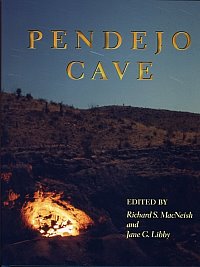
|
Pendejo Cave
Edited by Richard S. MacNeish and Jane G. Libby University of New Mexico Press 2004 1st ed. ISBN# 0-8263-2405-3 oversized cloth hardback This is a book you’ll spend hours and hours perusing. Located on a military base, Pendejo Cave was just another fascinating ancient occupation until researchers made several startling finds--- so startling, that the resulting hubbub from the worldwide press, caused the military to stop all work at the site fearing they’d lose control of the base. What was found there could change the face of American archaeological history. MacNeish writes, “We were digging up a number of chunks of clay in zone I, underneath a fire pit in H, and one of the people noticed a peanut-sized piece of burned clay that had some little round parallel rings on it. We began to look at other pieces of clay, including some still in situ, and there were lots of other little rings on it, so they brought them back to the lab.” This momentous find turned out to be preserved ancient fingerprints! Further investigation in the same area where the fingerprints were found turned up clay with bits of human hair that MacNeish was able to have analyzed. The results were a bit surprising to everyone: the hair carbon-dated to be 75,000 years old! Since the prevailing opinion is that the oldest dates of occupation in America were Clovis—12,000 years old, the Pendejo claim is astonishing and controversial. The three-year long excavation of Pendejo cave turned up an amazing twenty-eight occupation levels. Unfortunately, this has also complicated the dating process, as people turned over strata each time they dug pits for fires, or during other occupational activities, frequently exposing older burned wood and such, mixing it with later strata, and contaminating carbon needed for testing. But archaeologists seldom get perfect sites, and so the book becomes a great detective story where the reader is shown the complex manner in which researchers make their arguments, and attempt to prove the validity of a controversial find--- outstanding stuff! Pendejo Cave contains every single bit of data returned from the cave. It is profusely illustrated and well written. Are the fantastic claims true? Time will tell, but after you read the book you can make up your own mind about this fantastic site. Pendejo Cave is listed on its press release as costing
$85.00 for
the hardcover edition, but actually sells for $45.00 at the University
of New Mexico website, which you can access here. reviewed
by
Bob
Wishoff
|
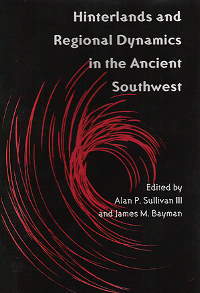 |
Hinterlands and
Regional Dynamics in the Ancient Southwest Edited by Alan P.
Sullivan III and James M. Bayman The
prehistoric Southwest
is best known for the Mesa Verde, Chaco,
Hohokam, and Casa Grandes cultural centers, yet a sizable volume of the
archaeological remains come from outside their immediate locales; Nels Nelson referred to these disparate
regions as the Ancient Pueblo Center (incorporating both the historic
Western
and Rio Grande Pueblos) and the Ancient Marginal Zone.
This volume consists of a series of essays
dedicated to a broader understanding of the interactions which
existed
between these smaller archaeological sites and the larger heartland
regions. Its
layout specifically addresses in
different chapters the smaller outlying areas of the Lower Verde
Valley, the
Tonto Basin, the Middle San Pedro Valley and Southwestern Arizona, the
Mimbres,
Southeast Arizona and Southwest New Mexico, Papagueria, the Sierra
Blanca and
Salinas districts, the Grand Canyon and Coconino Plateau, Mesa Verde,
and
Cibola. By
attending to various methodological techniques of approach to the
relationships
that existed between the central population centers and the peripheral
hinterlands, each chapter contributes a unique outlook on the
underlying
thesis. The techniques utilized include
(but are not limited to) ceramics, mortuary practices, tree ring data,
lithic
assemblages, agricultural practices, economic associations, variants in
common
archaeological features, and rock art motifs. This
variety
of approaches is
useful not only to other researchers, but also for
the interested avocationalist as well. Affiliations
between the outliers and central cultural regions are not always
exclusive due
to temporal and spatial proximity to multiple cultural traditions, and
the
overview is that these relationships are more the result of dynamic
interactions
than of static traditions. As Duff and Schachner put it in their
chapter
(“Emergence of the Zuni: Organizational Transformations in the
Emergence of
Zuni”, p. 187), “…yesterday’s hinterlands can emerge tomorrow’s
heartlands. Appreciation and understanding
of the full range of a region’s historical dynamics demonstrates that
they are as
relevant and important as are those of heartlands.”
A
liberal number of line drawings and graphs are found throughout the 304
pages
of the book; the maps especially assist in visualizing the physical
locations of
the peripheral and central sites under discussion. This volume is
available directly from the
University of Arizona Press website (click here) for $45.00. reviewed by Charles
Swenson
|
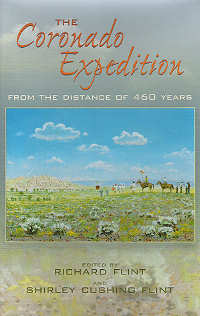 |
The As the first major encounter between the European exploring what was to become the American Southwest and its indigenous peoples, the Coronado Expedition was well documented. There is also an increasingly large body of archaeological evidence which lends balance to what is the often ambiguous or incomplete record left to us from the participants and the inevitable paper trail demanded by the Spanish bureaucracy of the time. This synthetic protohistorical approach, at least for this reader, provides the most exciting type of historical account. The interface between the artifactual evidence of prehistoric cultures and the written records of a literate society first encountering them allows for a reification of the events which is not only mutually enlightening but often reveals more than either method is capable of uncovering on its own. The 17 essays in The Coronado Expedition present a delightful combination of the insights resulting from such a collaboration. They are gathered from the conference on “Contemporary Vantage on the Coronado Expedition through Documents and Artifacts” held in 2000 at two locations. One venue was the New Mexico Highlands University, where work has been done on translating into English documents related to the expedition, and the other near the Jimmy Owens Site in the Texas Panhandle, where a campsite from the expedition has been uncovered. reviewed by Charles
Swenson
|
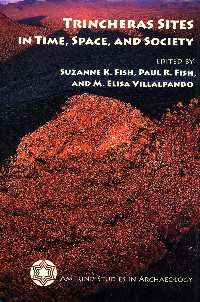 |
Trincheras Sites
in Time, Space and Society More background from the museum website: "Trincheras populations farmed the river bottoms of Sonora and also gathered wild resources and hunted in the surrounding hills and mountain chains. Some of these people lived in houses constructed in shallow depressions (pit houses)—much like the Hohokam to the north, while others lived on terraces built into the sides of the volcanic hills that dot the landscape. These terraced sites are often
termed Cerros de Trincheras (“terraced hills”). The terraces that
characterized these settlements served several functions. They were
house platforms for small structures constructed of the local volcanic
rock and—because they caught water running off the slope of the
hill—they also were planted with crops for house gardens and small
fields. They may also have served a defensive role: local populations
could withdraw to these platforms and bombard their attackers with
spears and stones. Ritual, or ceremonial, structures are often found on
the summits and at the bases of these hills." Trincheras sites are all hard to get to, and even harder to discern from lower ground. The chapter on photographing trincheras sites rounds out the book, wherein Adriel Heisey tells us his thoughts about flying ultralight aircraft for the task. "Coming down from the sky to fly slow circles around a trincheras site feels like a boyhood dream come to life: a windswept hill, ringed with stone walls old as a medieval cathedral, but holding stories only the dirt can tell...". What a pleasant way to end the book! The greatest value of the book lies in its comprehensive reporting, its compilation of work--- you won't be disappointed. Trincheras Sites in Time, Space and Society can be ordered direct from the publisher for $55.95, by clicking here. reviewed
by
Bob
Wishoff
|
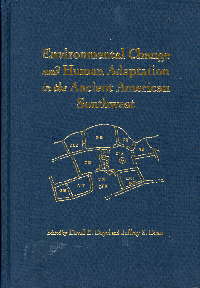 |
Environmental Change and Human Adaptation in the Ancient
American Southwest
This 344 page, hard cover book can be found at the University of Utah website, here , for $45.00. reviewed
by
Charles
Swenson
|
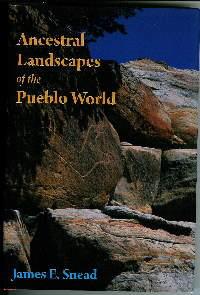 |
Ancestral Landscapes of the Pueblo
World
reviewed by Spencer
LeDoux |
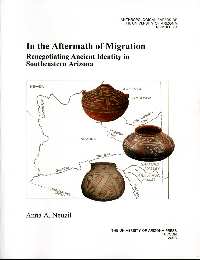 |
In the Aftermath
of Migration:
reviewed by John Benedict
|
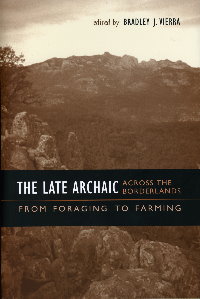 |
The
Late
Archaic Across the Borderlands From Foraging to Farming edited by Bradley J. Vierra University of Texas Press 2005 1st ed. Cloth Hardback ISBN# 978-0292-70669-9 One of the most poorly understood transitions in human history is that from life as a forager to life as a farmer. Why did people shift their lives in such a radical fashion? Why did they choose a more sedentary life? In what ways did this change in their diets affect their lives? These are but some of the questions asked by researchers from around the world. Increasingly, researchers are finding that the answers to these questions are more variable than once thought. The Late Archaic Across the Borderlands presents the reader with a selection of work focused on the development of agriculture in the North American Southwest, specifically contrasting two regions covering a linear distance of 1200km. The authors define the ?Late Archaic as the period at the end of the Late Holocene from 4500-2500 b.p.. Presented papers examine the environmental, cultural and biological factors that possibly led to the development of agriculture, as well as posit rationales for observed variations. The book contrasts hunter-gatherer (foraging) groups in the Trans-Pecos and South Texas areas with agricultural groups of the Sonoran and Chihuahuan deserts of Mexico and Arizona. By presenting these contrasts, the editor believes it should become more evident what conditions are necessary for the developement of agriculture and village life. As one might expect, environmental changes during the Late Archaic had a powerful influence for both foragers and agriculturalists. While the book presents a reader with a great deal of technical information, each paper does a good job of summarizing presented data, thereby making the book accessible to both professional archaeologist and avocationalist alike. Those interested in paleoecology, stone tool technology, and the history of the region will also find the book immensely useful and informative. Each paper is excellently referenced, making the book a valuable source for futher research in the topic. The Late Archaic Across the Borderlands can be ordered direct from the publishers. Originally priced at $60.00, the cloth hardback is on sale online for 33% off, or $40.20--- order your copy by clicking here. reviewed by Bob Wishoff |
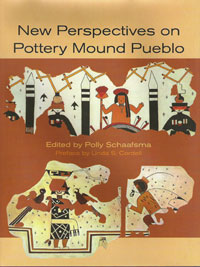 |
New Perspectives on Pottery Mound
Pueblo The
Pottery Mound site on the Rio Puerco in central New Mexico was the
subject of
numerous field school investigations by the University of New Mexico
Department
of Anthropology, starting in 1954 and extending into the early 1960s,
with
further work being done in the following decades .
It has been the source of numerous
unpublished papers, especially on the large amount of ceramics at the
site that
give rise to its name and the outstandingly colorful murals found in
kivas
there. However, as was all too common in
those days, published works on the site have remained scanty and the
field work
generally unavailable, and despite “its unusual wealth of
archaeological
potential has often been marginalized or overlooked altogether in
regional
syntheses of the Pueblo IV period.” After
the death of the initial investigator Frank Hibben in 2002, his papers
and
personal collection were contributed to the Hibben Center at the
University of
New Mexico, where they reside with the rest of the Pottery Mound
collections. This volume is a magnificent
synthesis of
this work and gathers it together in a delightfully colorful book that
serves
to raise the visibility of this site’s work to the level it deserves. Starting
with
an overview of the significance of the work and the reasons for
its
relative obscurity in the mainstream, it goes on to deal with Hibbens
early
work at the site, providing insights into the nature of academic
archaeological
excavations as it progressed over half a century. The
architecture
of site is then dealt with,
with a large number of detailed maps not only of the site itself but
it’s
location in relationship to surrounding communities.
There is also analysis of the “dynamics of
segregation and incorporation at Pottery Mound” by a detailed analysis
of the
wide variety of ceramic types, tempers and iconography and what they
can reveal
about immigration patterns at the site. One
of the most intriguing aspects of Pottery Mound is the number of intact
kiva
murals, and it is here that the attention paid to presentation in this
book
shines. It is illustrated throughout
with color and black and white photographs and depictions the murals
found
within the kivas. One reads about these
murals at other sites but it is here that one can get a real feel for
the
visual impact that they were designed to make. The
tremendous
amount of work that went into preserving
these delicate
plaster paintings, both in colored field drawings and attempts to
physically
preserve and move them, is a story in and of itself, on that has been
dealt
with by other authors such as Watson Smith. Here
a
wider interpretation is given as well, with
separate chapters on
ritual costumes and relations to rock art lending a wider understanding
of
these symbols. This
is a wonderfully illustrated book, nicely constructed and pleasant on
the eyes
in a way that is rarely found in an archaeological gook of this stature
and
importance. It has over a hundred color
photos and 50 black and whites, and over 13 maps, not including the
site
maps. It doesn’t spare technical detail
yet lends itself to an easy reading style, enhancing the readers
understanding
not only of the archaeological findings at Pottery Mound but of the
process by
which such discoveries not only become known but by which they can also
lie in
obscurity for decades despite the richness of the find.
And this is one book that does not deserve to
lie in obscurity before it becomes discovered for the jewel it is. Available from the University of New Mexico
Press in hardcover for $55.00. Click here to
order. reviewed
by
Charles
Swenson
|
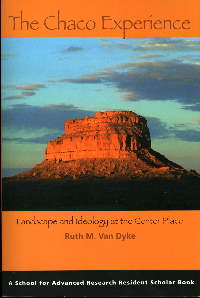 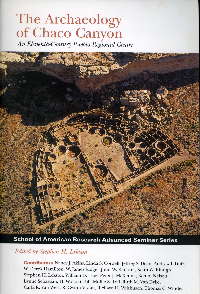 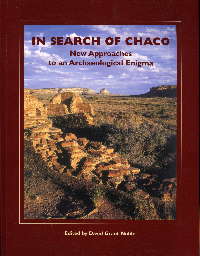 |
The
Chaco Experience: Landscape and Ideology at the Center Place The
Archaeology of Chaco Canyon: An Eleventh-Century Pueblo Regional Center In
Search of Chaco: New Approaches to an Archaeological Enigma One of the great
joys of reviewing books on archaeological sites is being able to visit
a site
and to then see just how much those books can enhance one’s experience
of the
site. This was true for me with this set
of books on Chaco Canyon from SAR Press, and let me say that these
three made
for a far richer encounter with this premier site of Ancestral Puebloan
culture
in the American Southwest and a deeper understanding of the
archaeological work
that has gone on there over the past four decades.
In
Search of Chaco
serves as an excellent basic introduction to Chaco studies over the
past two
decades; basic but not simplistic. It’s
actually an updated edition of the author’s 1984 SAR publication, New
Light on Chaco Canyon, drawing on
material from the Chaco Project done by the University of New Mexico
and the
National Parks Service, the most ambitious archaeological project
undertaken in
the United States and brought to a belated fruition with the help a
series of
seminars held at the School for Advanced Research in Santa Fe. As David Grant
Noble states in explaining why he has re-worked his previous book, “(a)s some contributors point out, little basic
research – in archaeology, this usually means digging – has taken place
in the
past twenty years. What has happened has
been less a product of shovel and trowel than of the mind: analysis,
comparison, interpretation, discussion, and debate.
New questions are being asked and old ones
reviewed. Where did the great-house idea
originate and how were these buildings used? What
are
the implications of a recently discovered
prehistoric natural
dam spanning Chaco Wash? How did these
ancient people organize themselves, their space, their time, their
world? Were they violent or peaceable? What, really, were the so-called roads? How does Chaco compare with other
archaeological sites in the world? Did
Chaco end in the 1100s or carry on in some fashion?
These are some of the issues addressed in the
following pages.” Noble has gathered
together here essays here that touch on these questions and many more
as
well. Hopi and Navajo traditions
regarding Chaco find voice, as well as “a Pueblo woman’s perspective.” There are contributions here from such
eminent lights of Southwestern archaeology and Chaco research as
Stephen H.
Lekson, Thomas C. Windes, R. Gwinn Vivian, Ruth M. Van Dyke, Linda S.
Cordell,
and many others. There is even a chapter
on the past century of work at the site by a perennial favorite of
mine, that
grand old lady of archaeology in the American Southwest, Florence
Lister, whose
late husband played a key role in the Chaco Project. And there are a
bountiful number of photographs (including color), maps and figures to
enrich
the armchair explorer’s journey to be found here. It
is
a large (8 ½ x 11) book, easy on the
eyes, which seems much more than its 158 pages while covering most of
the
important concepts regarding Chaco not only as a specific site but in
its
larger cultural context. It can serve as
a leisurely read for the interested visitor to Chaco or insightful
overview for
the avocational archaeologist, while bearing the authoritative
imprimatur of
some of its most eminent researchers. Pick
it up for $24.95 paperback, or $59.95 cloth at the
SAR Press site (click here)
and
while there be sure to check out the opening chapter from W. James
Judge, ‘Chaco’s Golden Century.’ The
Archaeology of Chaco Canyon is
a bit more rigorous approach to Chaco, containing essays by many of the
same
contributors as In Search of Chaco. It is
one of the final productions the
archaeological program of the Chaco Synthesis Project, which was
“conceived to
evaluate, synthesize and critique the results of the National Park
Service’s
renowned Chaco Project…the most ambitious, innovative, and productive
archaeological research project ever directed and funded by the federal
government.” Established in 1969 and
beginning fieldwork in 1971, the Chaco Project “was a multifaceted
affair
including many natural science studies, remote sensing projects, Navajo
archaeology and history, and cultural resource management in and around
the
park.” The archaeological aspects of this
tremendous undertaking excavated over twenty sites, 1.5 million
artifacts, “150
linear feet of field noted, thousands of maps and more than forty
thousand
photographs. Twenty technical monographs
were published in two series…of readier access than conventional ‘grey
literature’ but less readily distributed than real books.”
Although at the height of this undertaking “…media
coverage was heavy, including PBS documentaries and trade books…there
was never
a final synthesis to evaluate and discuss the manifold findings of the
Chaco
Project.” A capstone
conference at the University of New Mexico in 2002 and a Chaco
Synthesis
advanced seminar at the School of American Research in 2004 led to the
publication of The Archaeology of Chaco Canyon, dealing with the
archaeological
aspects of the Chaco Project, as well as a companion volume, Culture
and
Ecology of Chaco Canyon and the San Juan Basin. Having
worked
on the project from early on,
Lekson has an excellent grasp on scope and significance of the immense
amount
of material that emerged over the years, and played a pivotal role in
organizing the synthesis seminars. Although
his
“attempts to entice several notable science
writers to attend
all the conferences came to naught”, he has drawn together material
from key
participants into what is one of the finest compendiums of the current
state of
knowledge on Chaco which is an importance source for professionals
while still
being very appealing and useful for the avocational archaeologist and
accessible for the interested general public. Although the well
presented background material on the Chaco Project and synthesis
conferences is
extensive and quite interesting in understanding the workings and
extent of a
$6,000,000 archaeological project, the real meat of the work lies in
the
expanded appreciation of the archaeology in the Chaco Canyon region,
its
origins, the broader influence of Chaco culture on throughout the
Southwest,
and the “post-Chaco world”. ‘Ecology and
Economy’ “synthesizes the major attributes of Chacoan environment
through time
and the consequences of environmental change for resource procurement
and
subsistence technology,” with a related appendix and several very
useful
pullout timelines which extend the subject in considerable detail. Lekson collaborates
on ‘Architecture’, which elaborates not only on the Great Houses and
smaller
sites of Chaco and related regions, but on the greater overall
cityscape of
“downtown Chaco” itself. The manufacture
and exchange of materials and artifacts is discussed in ‘Organization
of
Production’, and even dares to make the sort of observation one finds
all too
rarely in archaeology texts…”Part of what makes a time and place is
joy, and our
reconstructions are notably joyless. What
made people happy in Chaco? Things done
right and made well. The word right must be
emphasized here:
ceremonies, work, buildings, pots, jewelry. The
beautiful
setting with Fajada Butte, dramatic light on
spectacular
buildings, powerful rain and runoff, ever-changing inspirational views. Chaco was a social place providing helpful
connections, full storerooms, an exciting game of chance, or a race. It embodied balance and symmetry.” The outliers, Great
House communities in the larger region, as well as the roads which
connected
them, are assessed in ‘The Chaco World,’ while more local and regional
sociopolitical considerations are evaluated in ‘Society and Polity’,
origins in
“Chaco’s Beginnings.’ Architectural and
archaeological similarities with the San Juan Basin, the Hohokam, and
Zuni-Acoma areas are dealt with in ‘Notes from the North” and ‘Notes
from the
South’ respectively, while even broader interactions are appraised in
‘Mesoamerican Objects and Symbols in Chaco Canyon Contexts.’ Concluding chapters
dwell on ‘The Chaco Project in Historical Context’ and ‘The Chaco
Synthesis’,
with an appendix providing details on Chaco Synthesis meetings,
participants
and publications. The Archaeology of Chaco
Canyon is an absolutely invaluable work
for anyone interested in better understanding Chaco Canyon, as well as
for
appreciating the tremendous value of the work done over the past three
decades
by the Chaco Project or Synthesis. It is
available from the SAR Press website (click here)
for
$34.95 in paperback, or
$60.00 cloth. The introduction is also
available for viewing on the website. Ruth M.
Van Dyke, a former resident National
Endowment for the Humanities scholar at the SAR and participant in the
several
Chaco Synthesis seminars, contributing a chapter (‘Chaco’s Sacred
Geography’)
to Noble’s In Search of Chaco and
collaborating on another (‘Chaco’s Beginnings’) in The Archaeology of
Chaco Canyon. But it wasn’t until actually
visiting Chaco Canyon and
falling in love
with its magnificent views and vistas that I was able to fully
appreciate both the
depth of her archaeological vision and eloquent expression of it in The
Chaco Experience: Landscape and
Ideology at the Center Place. Before finishing
the first page I was hooked on her lyric description of not only Chaco
Canyon
but the surrounding horizon’s pull. “The
north wall of Chetro Ketl undulates and bulges, its banded masonry
mimicking
the Menefee shale and Cretaceous sandstone behind the great house. A line of multiple doorways in Pueblo Bonito
telescopes like a corridor through time. The
subterranean
passageway at Casa Rinconada hints at
esoteric ceremonies
in the dimly lit great kiva… Chaco Canyon draws its power not only from
the
ancient architecture sheltering beneath its walls but also from the
ever-changing light and the far-flung vistas of the Colorado Plateau. From high above the canyon floor, the San
Juan Basin stretches away in sedimentary waves lapping against
mountainous
shores. Bands of golden sunlight
illuminate distant swaths of Tertiary and Quaternary sandstone. To the west, the Chuskas sleep the deep blue
sleep of the Cretaceous, indented by Narbona Pass with its promises of
chert
and wood. To the south, flat-topped
Hosta Butte peeps coyly above the dark line of the Hutton Plateau. Around a canyon bend, Fajada Butte’s isolated
knob like the controls of some giant chronometer.” She does admit that
she finds it difficult to part with “cherished factoids” and attempts
to limit
them to footnotes at the end of chapters; such passion for ones work
may be
more of a positive attribute in archaeological literature than is
generally
accepted and certainly welcome for the reader who is reading out of a
similar
passion for the subject. Truth to be
told, the bulk of Van Dyke’s writing is of the more rigorous variety
one would
expect in a book of its gravity, but her “conceptions of Chacoan ritual
landscapes and sacred geography” still permeate throughout. Although the modern eye tends to view Chaco’s
location and empty and barren, the daily experiences of those who
established
Chaco incorporated their experience of this environment into their
cosmology
and ultimately into their architecture. This
temporal
and spatial landscape of the Ancestral Puebloans was imbued
with
meaning over cycles of time and vast interrelated spaces. She sees this
Chacoan
roots in Basketmaker and Pueblo I settlements growth to agricultural
villages,
incorporating “periodic agricultural rituals” during the Early Bonito
phase in
which more communities began to participate, blossoming into the
Classic Bonito
phase with formal great houses and great kivas with astronomical
overtones, and
maturing with the Late Bonito phase emerging north into the San Juan
Basin. She envisions five
major Ancestral Puebloan themes manifesting at Chaco.
She lists these as… “1. Sacred
geography. Unusual or highly visible
natural places such
as mountain peaks or springs might have been the sites of shrines or
votive
deposits. “2. Visibility. A concern with visibility might have been
expressed through architectural prominence, site positions, and lines
of sight
connecting buildings with features and with topographic landmarks. Lines of sight and roads might have linked
sacred
places to Chaco. “3. Movement. Roads, ramps, and staircases in Chaco Canyon
and nearby outlier great houses might have enhanced or restricted
access and
visibility and might have served as routes for ritual processions. “4. Memory. Buildings and features might have incorporated
references
to the recent
past and to more distant ancestors. “5. Cosmography. Chacoan architecture and landscape might have
represented cosmographic ideas such as cardinal directions, balanced
dualism,
and center place. These ideas might have
been tied into movements of the sun and moon.” Van Dyke did not
come to her view of Chaco lightly, and there is a great deal of well
researched
anthropological and archeological research incorporated here, as
evidenced by
her involvement with the Chaco Synthesis project. There
is
plenty of hefty references and
investigation of the relevant literature, with a generous bibliography
to back
her up, as well as numerous maps and illustrations.
It’s sometimes hard
when writing a review to extricate one’s personal experiences with a
book (I
was fortunate to be able to read a great deal of this book at Chaco and
it
helped guide my now personal relationship with Chaco.
And I can’t help but love an archaeologist
who finishes with a coda like her final paragraph.
“Today, in the
remote silence that is Chaco Canyon, thousand-year-old sandstone walls
still
shimmer in golden sunlight. Moons rise
and set, hawks circle overhead, and the storied landscape lies
breathing under
the turquoise sky, holding the myriad meanings that peoples continue to
inscribe upon this ancient center place.” This is a book that
I unequivocally recommend, certainly worth far more than the $34.95
(paperback
only) for which it can be had from the book’s website, click here. And, as with all other SAR Press books
reviewed here, the first chapter can be downloaded for free there, so
you can
see for yourself just what a delight this book really is.
The page for the
Chaco Digital Initiative, mentioned in Lekson’s book as an ongoing
digital
archive for materials on Chaco from the 1890s to the mid 20th
century, can be found at http://www.chacoarchive.org.
The collection of early texts available there is extensive and growing,
and the
image gallery has over 7600 photographs and should not be missed; the
views of
site appearances prior to fuller excavation and NPS restoration remind
the
modern visitor that these were indeed ruins before they were
transformed into
the Chaco Culture National Historic we see today. reviewed
by
Charles
Swenson
|
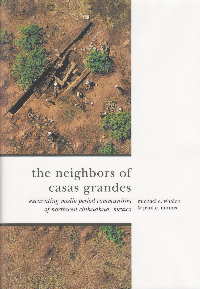 |
The Neighbors of Casas
Grandes This important book presents an examination of a little understood, and seldom studied area of Northern Mexico. The site, one of the largest in the region was one of the few "socially complex prehistoric civilizations in North America. The book is the result of over 10 years of surveys, excavations and fieldwork. The first part of the book explores still unanswered questions about the stucture and history of the Casas Grandes regional system. This system consists of a central core area, small villages, and adminitstative centers. Following chapters explore the chronologies, architecture and artifacts recovered from excavations conducted by the authors. Finally the authors provide analytical results which provide data for a discussion of the structure and dynamics of the Casas Grandes polity. Of particular interest to the researcher will be the large number of radiocarbon samplesused to date the sites. The authors took carbon samples from all four discussed sites and the recovered dates suggest a rethinking of the medio period into two phases, early and late. Also of interest will be the extensive chapter on Medio Period architecture, focusing on room chronology, and the chapter on ceramic technology development in the region. This book is a fantastic look at primary field research in all its detail, and will surely inspire other similar projects. Anyone interested in Southwestern Archaeology will want this book intheir library! Pick up a copy of The Neighbors of Casas Grandes directly from the publisher ($60.00, cloth hardback) by clicking here. reviewed by Bob Wishoff |
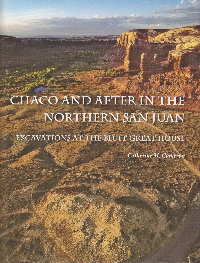 |
Chaco and After in the
Northern San Juan After catching the reader up on background nformation about Chaco and the Bluff Great House Project, the author presents what is surely the most complete summary of great houses and kivas across the Nothern San Juan, which includes portions of Northern Arizona and New Mexico, as well as portions of Southern Colorado and Utah. Cameron also performs a comparitive study, looking at great houses and kivas in both the northern and southern reaches of the "Chaco world"-- the northern San Juan area around Bluff, and the Cibola area around Zuni. What the author finds is a consistant chronology and construction sequence for most of the great houses and kivas. Cameron's chapter "Understanding the Bluff Great House" is quite interesting as she manages to summarize a vast amount of information about ceramics, projectile points, pollen samples, faunal remains, bone tools, ornamentation and construction techniques into a cohesive whole. Bottom line: the book provides key data that may begin to answer questions not only about Chaco and post-Chaco life in general, but also about how the people who made the outlying great houses interacted with Chaco Canyon. Curiously, Cameron is listed as author of this book and not as editor, as the book is comprosed of chapters not only by Cameron, but also includes those written by some of the most noted experts on Chaco culture and archaeology. Copiously illustrated, the book also includes a CD that contains all of the descriptions of artifacts recovered from the sites, as well as other raw data compiled for the study. No library of southwestern archaeology books would be complete without this important study! An interesting read for both amateur and professional alike, I predict that it will become one of the more influential books written on the topic and will soon sell out-- get your copy direct from the publisher ($75.00, oversized cloth hardback) by clicking here. reviewed
by Bob
Wishoff
|
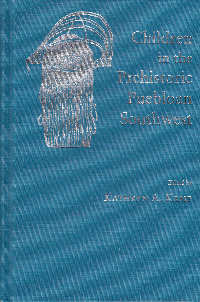 |
Children in the Prehistoric Puebloan
Southwest This
book arose from an April 2000 Society for American Archaeology
symposium, where
earlier versions of some chapters were presented. The variety of
subjects
covered by the chapters is not only enlightening but suggestive of
different
ways of looking at archaeological results with a view to the cultural
experience of children within the societies being investigated. Patterns
of
work assigned to children are examined, drawing in part on
ethnographic
studies of historic pueblos, as well the patterns of mentoring by
adults in the
expansion of the child’s ability and progress towards becoming a
functioning
member of the society. Puberty rites
among females as determined by contemporary Pueblo practices placing a
girl’s
hair into poli’ini, or butterfly
whorls, are correlated to similar hair whorls found in much older rock
art. The development of ceramic skill through
exploratory manufacture is studied by utilization of percentages of key
attributes in large collections, which is presented as a tool for
determining
the producer’s age. Photographs of
vessels and designs thought to have been made by child potters of
various ages
and skill levels illustrate these concepts. Levels
of
general pre-adult health, as determined by the presence of osseous
disease
patterns and dental properties such as porotic hyperostosis, Harris
lines,
periosteal infections and linear enamel hypoplasias, are scrutinized
among
skeletal remains. Mortality rates seemed
to have varied between large and small sites, with violence coming into
play as
major factor in adolescence, especially among males.
But with death coming to between 25% and 50%
of children before reaching adulthood, much can be learned about a
culture’s
beliefs by looking at their mortuary practices associated with these
burials of
youth, which are the subject of a comparison between them at Sand
Canyon Pueblo
and Grasshopper Pueblo. As
Nan
Rothschild puts in the introductory essay, “…it is long past time
to pay
attention to children, to see what we already know about them and what
we can
learn. The subject is important not only
because it provides data about children themselves but also because it
offers
significant information about society as a whole.” Children
in the Prehistoric Pueobloan Southwest is a welcome contribution
towards this
greater understanding of the role of kids in the past and a tool
towards better
investigating their role in the archaeological record in the future. It’s available from The University of Utah
Press from the book’s website (click here)
for the surprisingly low price of $20.00 for this 342 page, hardcover
book. What a bargain! reviewed
by Charles
Swenson
|
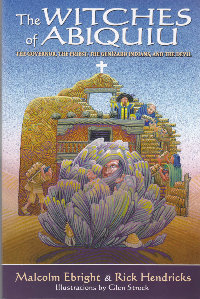 |
The Witches of Abiquiu: It was here, along the tenuous boundary of a colonial New Mexico still reeling from the effects of the Pueblo Revolt a century earlier that a delicate protective zone of protection from the raiding Comanche and Ute was established by the local Genizaro population. A mixture of displaced Plains, Hopi and Pueblo Indians, with an even broader blend rituals and beliefs, the Genizaro remained on the outer margins of acceptance by the Catholic church and other Spanish colonists with an eye on the sizeable land grant they had received from the colonial government to cement their stabilizing effect on a border plagued by raids from non-assimilated, hostile tribes. These tensions ultimately came to a boil when Fray Toledo came to believe himself under attack by indigenously invoked demons and decided to practice exorcisms and press charges of witchcraft against not only the perceived attackers but cuaranderos who sought to bring him some relief from his inner demons. Governor Velez Cachupin, whose precariously established protection against the raiding indio barbaros tribes by the pueblos and genizaros would be threatened by the acrimonious effects of these witch trials, and in his turn invoked hearings on the distressing charges and counter charges going on in Abiquiu. What he found there led him to eventually pass the case on to the Inquisition in Mexico City, which found Fray Toledo himself guilty of heresy and removed him from his offices. One of the more interesting aspects of this series of events deals with rock art locations, and how they were seen as “sites of devil worship in mid-eighteenth century New Mexico is a major theme of this book.’ Petroglyph panels at settings such as a nearly forty foot high tower made of adobe and stone where offerings were regularly left were undoubtedly ancient Pueblo religious settings, but priests saw them only as sites of devil worship and witchcraft practices needing exorcism. Many of the crosses found at surviving sites were believed to have placed in the process of clerical exorcisms of the sites, a culturally disruptive practice which probably played a role in the Pueblo Revolt of 1680 and that Governor Cachupin was hesitant to repeat. Unfortunately many of the related rock art sites and the associated Riano Pueblo now lie deep below the waters of Abiquiu Dam. Thanks to the obsessive documentation of the government and the Catholic Church in New Spain this is a richly detailed story. Many of the documents, though little known, had been translated before, but co-authors Malcolm and Hendricks have brought to light some material that had not previously been translated or transcribed. “The authors soon realized that there were several stories embedded in these manuscripts. The first story was the blow-by-blow description of the charges and countercharges leveled during the witchcraft trial itself. The first story was complicated by numerous ambiguities and ironies, particularly the question of whether some of what was reported as witchcraft was in fact Native American ceremonialism which the Franciscans did not understand and therefore categorized as evil Devil worship. By reading between the lines and interpreting the documents the Spaniards wrote, it was possible to discern hidden Indian voices.” Their story doesn’t stop with the trial either, going on to describe the role of this schism between the Genizaro community and the Church in the growth of the Penitente Brotherhood starting in the 1820s, and going on to document the continued echoes of the events of 1756-1766 in the community of Abiquiu today. This is one of the most complexly
textured accounts of
the precarious relationship that formed between Native belief systems
attempting to accommodate the imposition of the Church’s belief systems
in New
Spain, with one of the most refreshing outcomes of any such story. Due to the authorial skills of Malcolm and
Hendricks it is told in a manner that feels more like the unfolding of
a
psychologically nuanced novel than the copiously footnoted and detailed
accounting of a nearly forgotten historic event, with playful line
drawing
illustrations, photographs and glossary for the Spanish impaired. I hardily recommend it to anyone with an
interest in 18th Century New Mexico. reviewed by Charles Swenson |
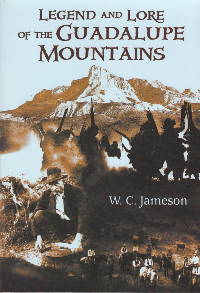 |
Legend and Lore
of
the Guadalupe Mountains The shadows of the Guadalupe Mountains veil mysteries and strange stories that reach not only far back into the past but impinge well into modernity. Telling these tales is a task that W.C. Jameson is imminently qualified for, having won three Stirrup Awards for Best Magazine Article, and has written dozens of books on buried treasure and the American West. Each of the twenty stories in his Legends and Lore of the Guadalupe Mountains stands easily on its own, while taken as a whole offers a historic overview of this still little known and underpopulated remainder of the past. The preface and introduction not only serve as insight into the region but the author’s strong personal ties to the area, adding that personal touch that a more scholarly approach would lack. While the material on prehistoric Indian and early Spanish influences in the area are of necessity scant, the period following 1850 is presented as an intriguing and richly detailed store of stories set against the background of the mountains. There is the mysterious Mescalero Apache village in McKittrick Canyon where in 1851 Lieutenant Richard Irving Dodge found 35 dead with no sign of violence inflicted against them, and the grave of the half Spanish, half Indian guide Jose Polanco, who after being killed by Indians was dug up a day later to have his corpse mutilated, shot by arrows and scalped. Of course there is the oft told enigma of the lost gold mine of Ben Sublett, often sought after but never found, as well as the tragic story of his son who been taken to this mine as a child but later misspent his life in a futile search for his father’s treasure. The Pinery, a Butterfield Overland Mail station at the mouth of Pine Canyon, serves as the setting of several stories, while the salt flats beneath El Capitan tell of the massacre of a 20 wagon train of west-bound Germans. But Jameson looks well into the twentieth century as well, including a mysterious tribe of Mescalero Apaches who were rumored to be hiding out in the mountains as late as 1950s, as well as the stories of, by his estimates, over 60 headless skeletons found in area since 1930. There is the much more contemporary legend of John Seven Oaks, who at the age of nine escaped after the brutal murder of his parents to live a semi-savage life in the Guadalupes, is thought to revenged his parents death by murdering their killers, and has been the subject of sightings in what was to become the Guadalupe Mountains National Park as late as 1977. There are even legends of a ghost B-24 Liberator bomber doomed to retrace its final fatal flight into the side of the Guadalupe Mountains, as well as a ghost house often seen but never relocated. There are even chapters on legendary wildlife, such as snakes, black panthers and bears. What a fun
book! And if you are so fortunate to be
planning a trip to the
wonderful wilds
of Guadalupe Mountains National Park, pick this up as a companion for
your
journey, as well as a delightful source for campfire stories; I just
wish I’d
had it along when I went there the year the park opened.
It’s very reasonably priced paperback which
can be purchased from the University of New Mexico Press website (here)
for
$16.95. Enjoy! reviewed
by Charles
Swenson
|
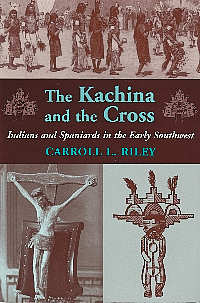 |
The
Kachina and
the Cross: Indians and Spaniards in the Early Southwest by Carroll L. Riley University of Utah Press
1999 ISBN 978-0-87480-773-8 paperback The tale story Spanish New Mexico in the sixteenth and seventeenth centuries is a tale often told, but few authors have told it in as lively and engaging fashion as Carroll Riley. The strength of The Kachina and the Cross lies in presenting not only a rich and lively picture of the Spanish explorers and settlers but an insightful and detailed description of the native Puebloans as they engaged in a clash of cultures that ultimately gave rise to the Pueblo Revolt of 1680. This was a time when the star of the Spanish Crown had passed its zenith and there was a greater parity of powers between the would-be settlers and the native populations. Political disruption was a norm among the settlers, with some 28 governors from 1598 to 1680, the ongoing threat of inspectors and the Inquisition, troublesome ecclesiastical relationships (often centered on treatment of the natives) and troublesome family feuds. Although there were uneasy treaties with most of the settled Pueblo communities and peaceful relations with other tribes necessitated by trade, the very real and often realized threat of attack from the nomadic Apache, Navajos and Comanche prevented any real degree of peace from breaking out. At the heart of many of the problems in the early Spanish Southwest was the ongoing effort of the Catholic Church to convert the indigenous inhabitants and establish missions, with an especial eye to the indoctrination of children into the church. Early in the seventeenth century there was a tense truce between native spiritual leaders, though with some attempts at subversion of religious practices and arrests at more distant Pueblos. But in an attempt to further entrench their authority the Franciscans eventually began a more overt attack on the Pueblo culture, including prohibition of their kachina dances. Such suppression of their religious practices drove them and their religious leaders underground, only to violently emerge in 1680as an underpinning of the Pueblo Revolt and resulting in the decade long expulsion of the Spanish church and state from New Mexico. reviewed
by Charles
Swenson
|
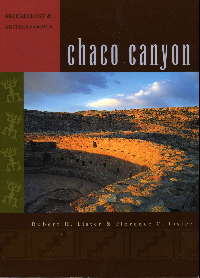 |
Archaeology and
Archaeologists: Chaco Canyon by Robert H. Lister and Florence C. Lister University of New Mexico Press 7th paperbound edition (2004) ISBN 0-8263-0473-7 This is a classical study on the emergence of archaeology studies at one of the preeminent archaeological sites by the finest husband and wife archaeologist teams working in the American Southwest. Their story of Chaco does not end with the abandonment of the site by the builders but rather begins with its rediscovery in the 18th and 19th centuries. It winds through the convoluted wrangling of the site away from Richard Wetherhill, George Pepper and the Hyde Exploring Expedition by Dr. Edgar Hewett and General Land Office agent S.J. Holsinger shortly after the turn of century, although Wetherhill continued to live at the site and operate a trading post until his murder there in 1910. Although designated a national monument by Theodore Roosevelt in 1907, until the National Parks Services came into existence in 1916 “administration of the monuments was handled by whichever federal department had jurisdiction over the land.” Work at the site stalled until the National Geographic Society’s survey under Neil Judd (aside from some excavations by ‘unknown persons’) in the ‘20s, followed by extensive work by University of New Mexico archaeologists and students and stabilization by National Park Services crews.
In 1957 a Visitor’s Center and headquarters were established to begin dealing with the more mundane tasks of archaeological interpretation, protection and management. To quote the Listers, “(t)o the regret of Americana buffs, old buildings fashioned from resources pilfered from the Anasazi or imitating the unique Navajo dwellings, which were left over from the Wetherhill, trading post, and university eras, were dismantled, to be replaced by characterless Park Service cinderblock administrative facilities and residences. The store, post office, and even the resident Navajos were banished from the monument. Only the unimproved access roads to the north and south, choked with sand and cut by ruts in dry spells and a slough of mud in wet ones, remained to remind travelers that this remote patch of the West was still wild.” But this was hardly the end of archaeological work at Chaco, with the newer chapter in investigations most familiar to public now opening with the Chaco Center in 1971. The complex road system underwent mapping, an understanding of the complex water management systems began to evolve, and the importance of the role of earlier, less prominent sites found their place in the larger overall picture of Chaco Canyon. Although the book ends a mere decade after the establishment of the Chaco Center and its view of the Centers significance is necessarily limited, the story certainly goes on from there. However, the Listers have written one of the finest prologues to that ongoing story of archaeologists and archaeology at the site, bolstered by their travels in many of the same circles as a numerous protagonists found in this book. The writing is clear and accessible to the casual reader, with a fine clarity that illuminates with a delightful lightness the subject as it is unearthed. There are many reasons to love this book besides the excellent writing. The 70 plus photos are real jewels in the rough, not the usual polished high definition pictures of the renovated ruins but of the sites prior to their full excavation and restoration. There are also speculative illustrations of sites as early workers thought it might have looked at its height. There are not only more recent high altitude aerial photographs illustrating the road system, but a shots by Charles and Anne Lindberg and others at earlier stages of excavation and stabilization. A 45 page appendix “lists all archaeological sites in, or immediately adjacent to, Chaco Canyon National Monument that have been excavated, tested, stabilized, or from which tree-ring samples have been collected” and “includes all of the major Chaco Anasazi communities and most of the other ruins that have been examined by archaeologists” grouped by developmental phases. There are also detailed schematic plans of the major ruins in this appendix, in addition to the other plans and maps scattered throughout the book. reviewed
by Charles
Swenson
|
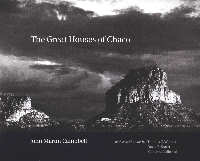 |
The Great Houses
of Chaco by John Martin Campbell, with contributions by Thomas C. Windes, David E. Stuart and Katherine Kallestad University of New Mexico Press 2007 1st Edition ISBN 978-0-8263-4248-5 In addition to be a tremendously important archaeological site, Chaco Canyon is also home to some of the most starkly photogenic antiquities in the United States. From 2004 2005, anthropology professor and amateur photographer John Martin Campbell worked together with National Park Service archaeologist Tom Windes and others to capture the 55 stunning photographic plates that make up the bulk of this book. This was no mean feat. Campbell was working with large format (4x6 inch) black and white film taken with heavy tripod mounted cameras, composing the upside down and backward images under a heavy black cloth in the fashion that is associated in the popular imagination more with the end of the 19th century than the beginning of the 21st. But this technique has captured the timeless feel and haunting beauty of the landscape and its manmade features reproduced in this volume. The range of subject matter here is surprisingly satisfying. Many focus on aspects of the landscape which are intrinsic to Chaco - Fajada Butte, South Gap, El Escalon, the badlands, the Chaco River tributary which gives rise to the canyon itself - as well as some of more basic modifications of that landscape, such as petroglyphs and the South Mesa stone steps. Some are of pottery and even of a midden shard bed, significant in that ceramics play such an important role in dating Chaco. But the lion’s share of the photographs here are of the abundance of existing architecture that has brought so much attention to the Chaco Canyon. They are presented in a roughly chronological fashion which helps to develop the sequence of building techniques, and while many are of the more famous edifices along downtown Chaco known to the casual visitor, such as Pueblo Bonito, Hungo Pavi, Chetro Ketl, Kin Kletso and Una Vida, there are also numerous structures that are rarely seen, such as Kin Bineola, Casa Chiquita and Wijiji. But this book is more than just gorgeous eye candy. Each plate is accompanied by an in depth caption by Katherine Kallestad, and there is an introductory chapter by Tom Windes on Chaco and Its Architecture as well as a concluding chapter by David Stuart, Chacoan Great House Society. In total, The Great Houses of Chaco serves not only as an appealing coffee table attention getter, but as an up to date introduction to the history of Chaco Canyon. This oversized
(10.5 x 8.5, 168 pages) hardcover edition,
first released in 2007, is still available from the University of New
Mexico
Press here,
though
stocks are low and you should call first for availability.
Hopefully, it will be re-released soon; this
is one book that any admirer of Chaco will appreciate, so be sure to
check now
if you want to be sure to get a copy! reviewed
by Charles
Swenson
|
| Home | Gallery | Latest Finds | Back to Main Book Review Index |